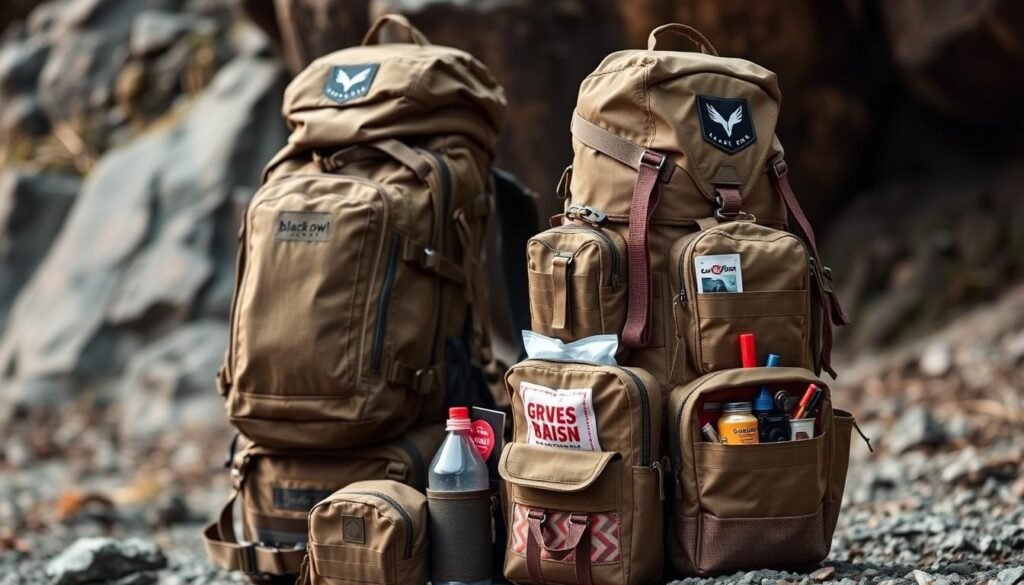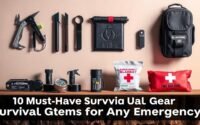Ultimate Bug-Out Bag Packing List: Essentials for 2025
Nearly one in three Americans will face an evacuation-order event in their lifetime, yet most people scramble when seconds count.
Proper planning and consideration are two of the more important keys in survival prep. You need a practical 72-hour kit that helps you move fast and stay flexible.
This short guide shows you how to assemble a realistic, modern bag that prioritizes real-world evacuation over wilderness fantasy. Focus on core categories: shelter, water, food, first aid, documents, and communication.
Keep your load light enough to stay mobile. Use a bedside WUSH bag for immediate exits, and pair it with a main kit that reflects likely destinations—family, hotel, or shelter.
Key Takeaways
- Plan for a 72-hour, mobile solution that covers basic survival needs.
- Prioritize lightweight, multiuse gear and avoid heavy tools early on.
- Use a bedside WUSH bag to save precious exit time and protect IDs and meds.
- Choose your bag type—rolling case or backpack—based on mobility and personal limits.
- Keep documents and backup power accessible to reduce stress during evacuation.
Your 2025 Survival Mindset: Plan First, Pack Second
Start with a plan: your choices matter more than every single item you toss into a kit. Proper planning and consideration are two of the more important keys in survival prep. Take them seriously and build from clear objectives.
Decide your horizon: are you preparing for a 72-hour evacuation or a longer INCH scenario? The difference changes transport needs, reusable supplies, and whether wheels or a ruck make sense.
When you first set up a bag, map two to three likely destinations—family, hotel, shelter—and sketch alternate routes. That reduces stress during an event and helps you pick realistic gear for most people’s actual experience.
- Define the objective before buying anything.
- List dependents (kids, elders, pets) and their must-have meds or documents.
- Start core-first: test a short overnight, then add selective upgrades.
- Plan comms: who you’ll contact and how if cell networks strain.
Keep a simple checklist and schedule a quick quarterly review. A clear, rehearsed step keeps you calm and ahead when an emergency changes everything.
Bug-Out Bag Defined: 72-Hour Kit, Not a Mobile House
A bug bag is a compact 72-hour survival kit built for quick evacuation and short-term self-reliance. It keeps you mobile and covers basic needs until you reach stable shelter or services.
Names vary — Go Bag, 72-Hour Bag, or Bail Out Bag — but the purpose is the same: get out safely and stay functional. Don’t try to replace your home; keep the bag light and focused on real emergencies like floods, fires, storms, or earthquakes.
Where you’ll likely go first: family or friends, a hotel, or an official shelter. Pack items that help in those settings: a change of clothes, toothbrush, sleeping mask, and earplugs.
- Structure contents by category: environmental protection, water purification, food and fire, sleeping comfort, and first aid.
- Prioritize a stainless bottle you can boil in, a real filter like the Katadyn BeFree, and Aquatabs as backup.
- Choose a backpack for wearability; a rolling bag works if you need more volume without extra strain.
Take this seriously: proper planning and consideration are two of the more important keys in survival prep. Treat your bug bag as a short-term tool with clear limits, not an inch-by-inch replica of home.
INCH Bag vs. Bug-Out Bag: Know Which One You Need
Deciding whether you need a short-term 72-hour kit or an indefinite relocation setup starts with one simple question.
INCH stands for “I’m never coming home.” It changes how you think about survival. An inch bag is meant for long-term displacement. It prioritizes reusable sources like solar power, durable shelter, and tools you can rely on indefinitely.
Compare time horizons: a bug bag gets you through 72 hours. An inch kit prepares you to live away from home resources. That difference alters your gear, weight, and transport choices.
“Proper planning and consideration are two of the more important keys in survival prep. Take them seriously.”
- Transport: INCH often needs a vehicle or a rolling 120‑liter duffel to carry a family tent, bulk food, and a power station.
- Packing tips: place dense items (food, tent) low, lighter clothes and tarps higher, and long‑handled tools along the sides for rigidity.
- Combo approach: use a framed backpack for wear and a rolling duffel as an INCH add‑on when weight or distance changes.
Plan by threat and family needs. The right type of bag combo keeps you flexible if conditions shift mid-evacuation.
Start Smart with a WUSH Bag for Instant Evacuation
A five-second bedside pouch can change chaos into action during a night alarm. Keep one small, simple kit within arm’s reach so you can move before you think.
A WUSH Bag (“Wake Up, Stuff’s Happening”) is an ultra-portable pouch meant to bridge the first frantic minute of any emergency. It is not your main bug bag or an inch kit, but it gives you identity, access, and power when seconds matter.
What to keep bedside
- Wallet, phone, and car keys—place them in the pouch nightly so you make sure they are ready.
- Compact power bank and charging cables to keep comms alive.
- Spare house and car keys plus a small flashlight for dark exits.
- USB drive with scanned documents and photos, plus hard copies of IDs and title pages.
- Cash, essential meds, and a pair of old prescription glasses.
Keep the WUSH slim so it doesn’t slow your step while you gather family or pets. Use it every night and review contents quarterly to refresh cards, cables, and meds.
“Proper planning and consideration are two of the more important keys in survival prep. Take them seriously.”
Ultimate Bug-Out Bag Packing List: Essentials for 2025
Pack by purpose: choose items that earn their place in shelter, water, food, sleeping, and tools. Proper planning and consideration are two of the more important keys in survival prep. Take them seriously.
Environmental protection
Start with layers suited to your climate: base, insulating, and weather shells. Add a durable nylon poncho and a lightweight tarp for makeshift shelter.
Carry clothes clips and a length of 550 paracord to dry or rig gear on the move.
Water plan
Build redundancy: a Klean Kanteen you can boil, a Katadyn BeFree 1.0L filter, Aquatabs tablets, and a Platypus collapsible bottle for storage.
Food and fire
Pack a three-day food supply with dense items and snacks (trail mix, jerky). Include a stormproof match set and a windproof lighter for a reliable fire-starting kit.
Sleeping comfort
Bring a compact sleeping bag or blanket matched to your region. Add a small pillow, sleep mask, and earplugs to aid rest during stressful hours.
First aid and hygiene
Carry a well-stocked first aid kit, your medications, toothbrush, soap, wipes, TP, towel, and a small container of baking soda for cleaning and odor control.
Survival tools and documents
Use a comfortable backpack or wheeled pack, a multitool, headlamp and lantern with spare AA batteries, duct-tape-wrapped card, ziplocks, and laminated maps.
Keep copies of IDs and critical documents sealed and easy to grab. A roll of paracord (~100 ft) and a compact compass finish the core kit.
Proper planning and consideration are two of the more important keys in survival prep. Take them seriously.
- How to use this bag list: assemble by category, test the carry, then trim nonessential luxuries.
- Tailor gear: choice of brands and type should match your budget and local climate.
Communication, Navigation, and Lighting You Can Count On
When networks strain, a few proven devices will preserve contact, direction, and visibility. Build a compact comms and nav kit that sits in an outer pocket of your bag so you can grab it without unpacking. Keep cables and spare power ready.
Radios and power
Two-way radios like the Baofeng UV-5R are affordable and effective. They offer dual watch, 128 memory channels, and FM reception. Program local repeaters ahead of time and practice basic net etiquette.
Find your way
Carry a quality compass and laminated state map to resist rain. Add a whistle, signal mirror, and chem lights to attract attention in crowded or dark spaces.
Light the way
Choose a reliable headlamp (Fenix HL18R-T or Petzl TIKKA) for hands-free work and a compact lantern (Streamlight Siege X) for shared lighting. Standardize on rechargeable AAs like Eneloop to simplify spares.
“Proper planning and consideration are two of the more important keys in survival prep. Take them seriously.”
- You’ll keep a compact power kit: USB battery, phone cable, and radio charging cable.
- You’ll store comms in an external pocket so rain or stress won’t slow access.
- You’ll test radios periodically and note local weather frequencies for alerts.
- You’ll balance light output with runtime and choose water-resistant models.
- You’ll consider how this gear supports both a bug bag and an inch bag with added power.
| Item | Example | Why it matters |
|---|---|---|
| Handheld radio | Baofeng UV-5R | Affordable, programmable, FM and multi-channel comms |
| Power kit | USB battery + cables | Keeps phone and radio charged off-grid |
| Navigation | Compass + laminated map | Reliable direction when GPS fails |
| Lighting & signals | Headlamp, lantern, chem lights | Hands-free tasks and visible signaling |
Urban vs. Wilderness Add-Ons: Tailor to Your Environment
Different risks call for different extras—city streets need other tools than a mountain trail.
Urban and suburban add-ons focus on access, protection, and short-term repairs. Pack work gloves, N95 mask, safety goggles, a compact pry tool or breaching bar, and a sillcock key to access water in buildings. Include small straps of paracord and a multi-tool for quick fixes.
Wilderness additions
For trails and timber, add a durable axe or tomahawk (Estwing-style), a pocket chainsaw, a fishing kit, and a foldable camp shovel. These items help you gather wood, make shelter, and secure protein while you stay mobile.
Threat-specific gear
Evaluate niche items when threats change. A full-face gas mask (MIRA CM-6M), a Geiger counter (GQ GMC-300S), potassium iodide tablets, and empty sandbags matter during CBRN or flood scenarios. An inch bag or an inch strategy often adds more cordage, larger tarps, and solar power for longer stays.
Proper planning and consideration are two of the more important keys in survival prep. Take them seriously.
- Keep add-ons modular so you can swap sets between bug bags and your main bag.
- Test gear and practice mask fit, pry tool use, and shovel work before an event.
Weight, Fit, and Packing Strategy for Real-World Mobility
A sensible weight target and smart load placement make real-world travel reliable.
Set a target: aim to keep your packed weight under 25% of your body weight so you can walk briskly, climb stairs, and pivot quickly without fatigue. This rule keeps your feet moving when routes stretch longer than expected.
Load distribution: place bulk but lighter items, like a sleeping bag and spare clothing, at the bottom because they’re used at camp, not in transit. Put heavier items close to your spine and higher on flat ground to reduce strain.
Shift weight lower when terrain gets steep or rough. That simple change improves balance and reduces the chance of toppling on uneven trails or slippery stairwells.
- You’ll pack frequently accessed items—water, snacks, headlamp, gloves—in outer pockets so you don’t have to empty the bag on the roadside.
- You’ll choose a framed backpack for long foot travel, adjusting torso length and hip belt for a snug, pain-free fit.
- You’ll switch to rolling bags when wheels clearly win: paved routes, larger loads, or to support older family members.
- You’ll lash tents, tarps, or sleeping systems to avoid sway; place long tools along the sides of an inch duffel to improve rigidity.
Proper planning and consideration are two of the more important keys in survival prep. Take them seriously.
| Scenario | Best choice | Why it matters |
|---|---|---|
| Long foot travel | Framed backpack | Better load transfer to hips and less fatigue |
| Paved or vehicle-assisted | Rolling bag | Lower injury risk and higher volume |
| INCH duffel | Duffel with dense items low | Stability while hauling and easier rolling |
Family Builds: Share Loads, Adjust for Kids, Pets, and Medical Needs
Coordinate family roles early so each person carries a manageable share of gear. This keeps overall weight down and helps you move faster when seconds count.
You don’t need every item in every bag. Share larger items across multiple packs and keep small carriers under ~25 lbs. Distribute shelter pieces—tent body in one pack, poles and stakes in another—to balance shape and load.

How to split shared items and responsibilities
- Shared gear: assign the cook set, tarp, and a bulk first aid kit to specific adults so no single carrier is overloaded.
- Kids and small adults: keep their packs light with comfort items and snacks; adults carry denser items.
- Pets: pack food, collapsible bowls, leashes, and vet records in a small pouch to avoid last-minute problems.
- INCH planning: stage a rolling inch bag duffel in your vehicle for family tents, extra food, and reusable resources.
- Practice: test-fit each kit on a short walk and adjust straps until all people can maintain pace safely.
Proper planning and consideration are two of the more important keys in survival prep. Take them seriously.
| Role | Typical carry | Why it matters |
|---|---|---|
| Group leader | Large first aid kit, maps, laminated contacts | Quick access to medical supplies and rally plan |
| Adult carrier | Tarp/tent body, food, water filter | Holds dense items so kids stay light |
| Rolling INCH duffel | Family tent, extra food, power bank | Vehicle-based reserves for extended displacement |
Maintenance, Updates, and Your Next Step
Set a simple routine to inspect gear so nothing surprises you during an evacuation. A short quarterly review and an annual deep dive keep your bag ready and your head clear.
Quarterly and annual checks, expirations, and life changes
Quarterly: run a quick pass on perishable items, meds, and batteries. Rotate expiring rations into daily use so nothing goes to waste.
Annual: do a full inventory. Replace used or borrowed gear and verify expiration dates on food, water, and first aid supplies.
Update for life: adjust the list when family needs change—new prescriptions, kids growing, or a pet added. Store kits in low-humidity, room-temp spots.
Keep learning: skills, city vs. rural kits, and EDC to bridge the gap
Expand your skills so equipment works in the real world. Learn radio basics, map and compass, water treatment, and firecraft.
Refine separate urban and wilderness loadouts. Swap urban tools for outdoor gear depending on likely routes. Bridge everyday carry to your bug bag with a small pocket kit so a minor emergency doesn’t stall you before you reach the pack.
Bookmark this guide — we continually update with the latest survival info
Bookmark this guide and return often. We revise recommendations and add field-tested insights so your next step is always informed.
“Proper planning and consideration are two of the more important keys in survival prep. Take them seriously.”
- You’ll run quarterly checks for perishable items and annual deep dives for full inventory and batteries.
- You’ll make sure expiring rations, meds, and batteries get rotated into normal use.
- You’ll adjust your list for life changes and maintain tools by cleaning and oiling metal parts.
- You’ll consider staging an inch add-on or an inch bag and review it each year as family or threats evolve.
| Task | Interval | Why it matters |
|---|---|---|
| Perishable rotation | Quarterly | Keeps food and water fresh and reduces waste |
| Full inventory & testing | Annually | Finds worn gear, expired meds, and dead batteries |
| Skill refresh | Semi-annual | Ensures you can use radios, filters, and first aid under stress |
| Life-change update | As needed | Matches your bag to new medical needs, pets, or routes |
Your next step is to set calendar reminders for seasonal swaps and a yearly audit. Make sure you test gear in real conditions so the kit, the bag, and your skills work together when an emergency arrives.
Conclusion
Finish strong: inspect your bag, weigh the load, and run a short carry test so your kit earns its place in an exit plan.
Keep it lean: focus on core bug items that support survival at shelters, hotels, or with family. Prioritize water, food, sleeping gear, and first aid when you edit contents.
Reserve an inch setup only when your world changes and long-term reuse matters. Practice drills, rotate perishables, and share roles so everyone moves with purpose during an event.
One simple step today: start a WUSH pouch or weigh your current bag. Bookmark this guide and return often — we continually update picks and training so your readiness grows with real-world needs.
FAQ
What is the difference between a 72-hour kit and an INCH bag?
A 72-hour kit is designed to sustain you for about three days and focuses on lightweight essentials: water, food, shelter, and basic first aid. An INCH bag (“I’m Never Coming Home”) assumes long-term displacement. It includes more clothing, tools, reusable fuel sources, and extra supplies for weeks or months.
How much should my kit weigh?
Aim to keep your load under 25% of your body weight for sustained mobility. Prioritize water and shelter first, then add tools and comfort items. If you must exceed that, split gear among family members or use a wheeled solution for short-distance movement.
What are the must-have items for drinking water?
Include a durable bottle for boiling, a portable filter (like Sawyer Mini), purification tablets, and at least one collapsible bladder or container for storage. Plan for one gallon per person per day as a baseline.
Which first aid items should I include?
Your kit should have adhesive bandages, sterile gauze, tape, elastic bandage, antiseptic wipes, tweezers, a tourniquet, pain relievers, any personal prescriptions, and a compact first aid manual. Consider adding wound irrigation supplies and suturing tools only if you are trained to use them.
Do I need specialized tools like an axe or pocket chainsaw?
Only if your likely environment and plan justify them. Wilderness or long-term INCH scenarios benefit from a hatchet, pocket chainsaw, and camp shovel. Urban kits should favor pry tools, gloves, and a sillcock key for utility access.
What communication gear should I carry?
A charged smartphone with power banks, a hand-crank or battery-powered NOAA radio, and a reliable handheld transceiver like the Baofeng UV-5R are useful. Also include spare charging cables, solar chargers, and laminated contact lists.
How do I tailor a kit for children and pets?
Reduce individual pack weight for kids, and distribute shared gear like cooking and shelter items among adults. Pack kid-specific items: extra clothing, favorite comfort item, child-size life jacket if needed, and food. For pets, include a leash, food, collapsible bowl, vaccination records, and any meds.
How often should I check and update my supplies?
Perform quick quarterly checks for batteries, meds, and perishable food. Do a full inventory and refresh once a year or after any significant life change—moving, new medications, or family size adjustments.
What shelter options work best in mixed environments?
A lightweight sleeping bag or blanket, an emergency bivvy, and a 6×8 tarp with cordage provide versatile protection. Add clothes clips, a poncho, and a compact tent if you expect harsh weather or need privacy.
Should I include respiratory protection and radiation monitors?
Yes, when relevant. N95 or P100 respirators and eye protection suit urban scenarios with smoke or dust. For specific threats—industrial accidents or radiological events—consider a gas mask, potassium iodide, and a Geiger counter, but only purchase and use them based on credible threat assessment.
What’s the best way to carry important documents and IDs?
Keep originals in a waterproof, fire-resistant pouch in your main pack and store encrypted digital copies off-site or in secure cloud storage. Include cash in small denominations, copies of insurance, medical records, and contact lists.
How do I choose between rolling luggage and a framed backpack?
Choose a framed backpack for extended off-road travel, uneven terrain, or when you must keep hands free. Rolling luggage can work well for short, paved evacuations or when weight is high but distances are short. Consider hybrid solutions for family gear pooling.
What food should I pack beyond three days?
For longer contingencies, include durable staples: dehydrated meals, high-calorie bars, freeze-dried entrees, and cooking fuel. Pack lightweight cookware and a compact stove. Rotate and test foods annually to ensure palatability and expiry management.
How do I practice and test my kit?
Run a full pack drill: wear and carry your kit on a 4–8 hour hike, test sleeping gear overnight, and run gear on your stove and water filter. Practice communication drills with family and rehearse evacuation routes from home.
What legal or safety considerations should I know?
Check local regulations for items like radios, knives, and gas masks. Store fuel and chemicals safely, and get training for tourniquets, first aid, and tool use. Keep your plans compliant with evacuation orders and follow official guidance during events.


